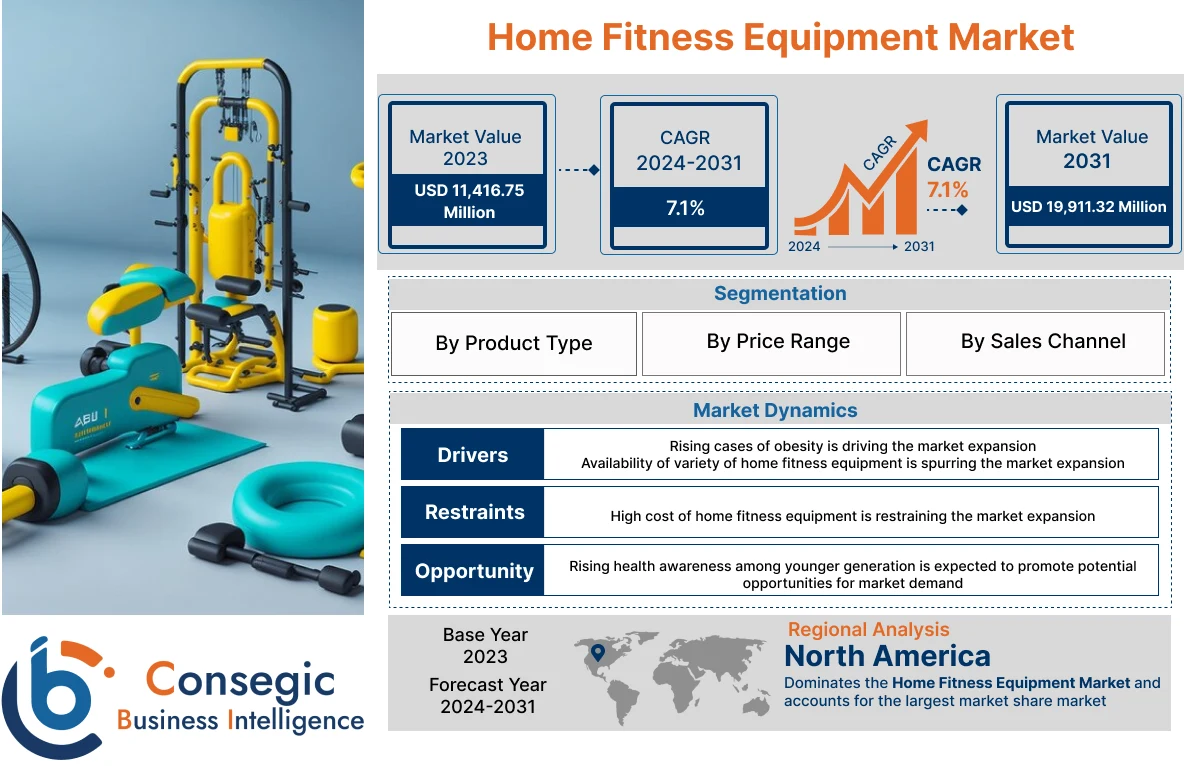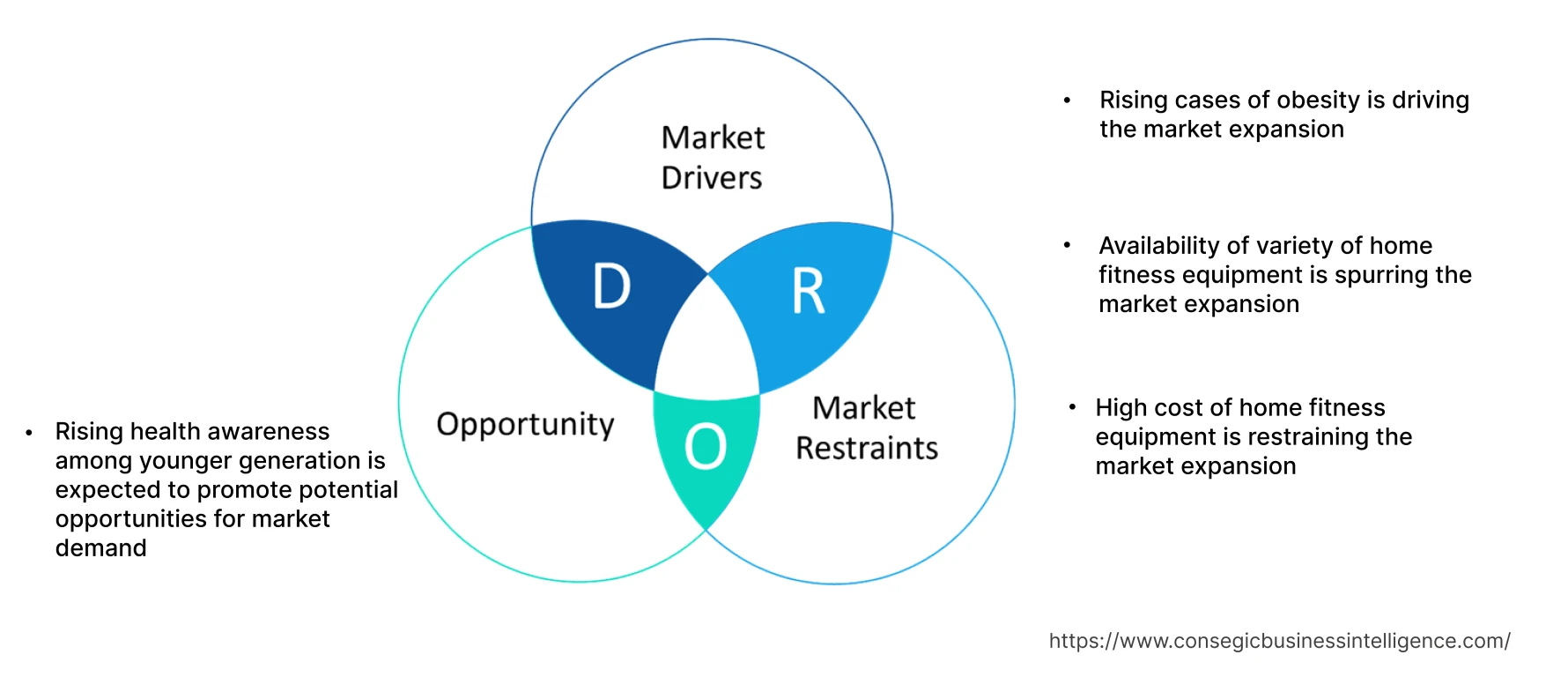- Summary
- Table Of Content
- Methodology
Home Fitness Equipment Market Size :
Home Fitness Equipment Market size is estimated to reach over USD 19,911.38 Million by 2031 from a value of USD 11,461.75 Million in 2023, growing at a CAGR of 7.1% from 2024 to 2031.
Home Fitness Equipment Market Scope & Overview :
Home fitness equipment refers to devices or apparatus that are intended to be used in a residential setup during physical activity to enhance the strength, conditioning effects, or outcome of an exercise routine. There are several types of fitness equipment that are often installed in homes including treadmills, elliptical machines, exercise bikes, rowing machines, strength training equipment, and other related equipment. Moreover, the integration of this equipment offers a range of benefits including time savings in commute, increased convenience, freedom to exercise as per the user requirement, and others, which are major determinants for increasing its deployment in residential setups.
Home Fitness Equipment Market Insights :
Key Drivers :
Rising cases of obesity are driving the market expansion
The significant rise in obesity rates across the world, specifically in urban areas is driving the market demand for fitness equipment. Equipment such as treadmills, exercise bikes, and elliptical machines are typically used for weight loss routines. Moreover, the integration of fitness equipment in-home workout sessions facilitates healthy weight loss as the equipment is integrated with advanced features including calorie and heart rate monitors that make it easy for users to track their progress. Factors including unhealthy eating patterns, lack of physical activity, genetics, health conditions, and high amounts of stress are key determinants for increasing the cases of obesity worldwide.
- For instance, according to the World Health Organization (WHO), over 1 billion individuals across the world are obese, among which adults account for 650 million, followed by adolescents with 340 million and children with 39 million.
- Additionally, according to the WHO European Regional Obesity Report 2022, nearly 1 in 3 children and two-thirds of adults in the European region live with obesity, while the obesity rates are growing in the region.
Hence, the rising cases of obesity are driving the market demand for this equipment to facilitate weight loss routine in the comfort of an individual's home, in turn proliferating the trends of the market.
The availability of a variety of home fitness equipment is spurring the market expansion.
Home fitness equipment manufacturers are constantly investing in the development of various types of fitness equipment including treadmills, elliptical machines, exercise bikes, and others with new features to ensure efficient utilization during exercise routine. Hence, these equipment companies are launching new products with updated features and advancements.
- For instance, in February 2021, Technogym S.p.A launched its MyRun series of home treadmills that are optimized to meet the requirements of the whole family while providing customized walking or running programs. The treadmill is appropriate for users of all levels ranging from beginners to sports enthusiasts.
- Additionally, Johnson Fitness & Wellness offers various types of home equipment including treadmills, elliptical machines, indoor cycles, upright bikes, and others.
- Similarly, Dyaco offers a wide range of fitness equipment that are easy to use, durable, and tailored for users of any ability to perform effective and convenient workout sessions at home.
Therefore, rising innovations and the availability of a broad range of these fitness equipment as mentioned above are stimulating the trends of the market.
Key Restraints :
The high cost of home fitness equipment is restraining the market expansion.
The high cost of home fitness equipment is a major restraint on market expansion, as the significant upfront investment required makes it less accessible to a broader audience. Many consumers find the prices prohibitive, especially when compared to more affordable alternatives like gym memberships, outdoor activities, or bodyweight exercises. Additionally, ongoing maintenance costs can further discourage purchases, while economic downturns lead consumers to prioritize essential spending over non-essentials like fitness equipment.
- For instance, BowFlex Inc. is a manufacturer of home fitness equipment that offers multiple series of home treadmills with average prices ranging from USD 1,200 to USD 1,500 per unit.
- Additionally, Johnson Fitness & Wellness offers several types of fitness equipment including elliptical machines ranging from USD 3,200 to USD 6,500 per set, depending on the type and specification of the equipment. Further, TRUE Fitness offers a broad series of treadmills for home usage ranging from USD 3,000 to USD 6,500 per unit, which is relatively very high.
Therefore, the high cost associated with these fitness equipment is constricting the trends of the market.
Future Opportunities :
Rising health awareness among the younger generation is expected to promote potential opportunities for market demand.
The rising health awareness among the younger generation is anticipated to present potential home fitness equipment market opportunities and trends in the coming years. The value of physical fitness and general health has been widely recognized in recent years. Moreover, the growing popularity of fitness and bodybuilding among younger individuals has resulted in a significant increase in home fitness equipment market demand.
- According to the World Youth Report 2020, the total number of young individuals aged from 15 to 24 years reached approximately 1.2 billion in 2020, accounting for 16% of the global population. Additionally, the number of youth is projected to grow by 7% and reach nearly 1.3 billion by 2030.
Further, the home fitness equipment market offers a range of benefits and enables users to perform anaerobic and aerobic exercises that play a vital role in improving overall consumer health and fitness. Similarly, as per the analysis, this equipment also helps in enhancing muscle strength, facilitating bodybuilding, and preventing health problems while improving overall user health and fitness.
Therefore, the growing prevalence of the younger population, rising health awareness among the younger generation, and the aforementioned benefits of this equipment in improving overall consumer health are anticipated to promote opportunities and home fitness equipment market trends during the forecast period.
Home Fitness Equipment Market Report Insights :
| Report Attributes | Report Details |
| Study Timeline | 2018-2031 |
| Market Size in 2031 | USD 19,911.38 Million |
| CAGR (2024-2031) | 7.1% |
| By Product Type | Treadmills, Elliptical Machines, Exercise Bikes, Rowing Machines, Strength Training Equipment, and Others |
| By Price Range | Low, Medium, and High |
| By Region | Asia-Pacific, Europe, North America, Latin America, Middle East & Africa |
| Key Players | BowFlex Inc., Johnson Fitness & Wellness, Dyaco, Origin Fitness Ltd, Rogue Fitness, Technogym S.p.A, TRUE Fitness, HOIST Fitness Systems, Decathlon SA, Core Health & Fitness LLC |
| Geographies Covered | |
| North America | U.S. Canada Mexico |
| Europe | U.K. Germany France Spain Italy Russia Benelux Rest of Europe |
| APAC | China South Korea Japan India Australia ASEAN Rest of Asia-Pacific |
| Middle East and Africa | GCC Turkey South Africa Rest of MEA |
| LATAM | Brazil Argentina Chile Rest of LATAM |
| Report Coverage | Revenue Forecast, Competitive Landscape, Growth Factors, Restraint or Challenges, Opportunities, Environment & Regulatory Landscape, PESTLE Analysis, PORTER Analysis, Key Technology Landscape, Value Chain Analysis, Cost Analysis, and Regional Trends & Forecast |
Home Fitness Equipment Market Segmental Analysis :
By Product Type :
Based on the product type, the market is segmented into treadmills, elliptical machines, exercise bikes, rowing machines, strength training equipment, and others.
The treadmills segment accounted for the largest revenue share in the year 2023. Treadmills are a type of fitness equipment that is mostly utilized for cardio training and helps in boosting overall cardiovascular health. Moreover, the utilization of treadmills offers a range of benefits including improved cardiovascular health, weight loss, improved bone and joint health, ease of customization, and others. The aforementioned benefits of treadmills are key determinants for driving their utilization in-home workout sessions.
- For instance, BowFlex Inc. is a manufacturer of fitness equipment that offers T616 and T618 models of home treadmills in its product portfolio. The company's home treadmills are equipped with performance tracking, a built-in USB charging port, LCD, and heart rate monitors among others.
Thus, as per the home fitness equipment market analysis, the increasing advancements associated with treadmills are among the prime factors driving the market.
The strength training equipment segment is anticipated to register the fastest CAGR during the forecast period. Strength training equipment is designed for use in resistance training which utilizes the resistance to cause muscular contraction to build strength, size of skeletal muscles, and anaerobic endurance. Strength training equipment includes weight machines, dumbbells, benches, leg presses, and others. Moreover, the utilization of strength training equipment offers several benefits including improved muscle strength, weight management, enhanced mobility and balance, increased muscle-to-fat ratio, and improved posture among others.
- In March 2023, Rogue Fitness is a manufacturer of these fitness equipment that offers a wide range of strength equipment intended for home usage in its product portfolio. The company's home strength equipment series mostly comprises weight machines, benches, and others.
Therefore, the increasing development of strength training equipment for utilization in-home workout settings is anticipated to boost the home fitness equipment market demand during the forecast period.
By Price Range :
Based on the price range, the market is segregated into low, medium, and high.
The medium segment accounted for the largest home fitness equipment market share of 52.05% in the year 2023. Based on the analysis, the expansion of the medium price range segment is attributed to several factors including the growing popularity of physical fitness and wellbeing along with rising demand for good quality equipment at an economical price among others.
- For instance, Rogue Fitness offers a broad range of fitness equipment including strength training equipment such as adjustable trainers, weight machines, functional trainers, and others at a medium price range of USD 300 to USD 1,000.
Hence, the rising availability of medium-priced fitness equipment is driving the home fitness equipment market expansion.
The high-price segment is expected to witness a significant CAGR during the forecast period. Factors including rising disposable income, increasing purchasing power of consumers, and rising demand for high-quality fitness equipment with a wide range of features are fostering the expansion of the high-price range segment.
- For instance, TRUE Fitness offers a broad series of equipment including treadmills, elliptical machines, exercise bikes, and strength machines ranging from USD 3,000 to USD 6,500 per unit.
Thus, the increasing development of high-range fitness equipment, equipped with broad features is expected to boost the home fitness equipment market trends during the forecast period.
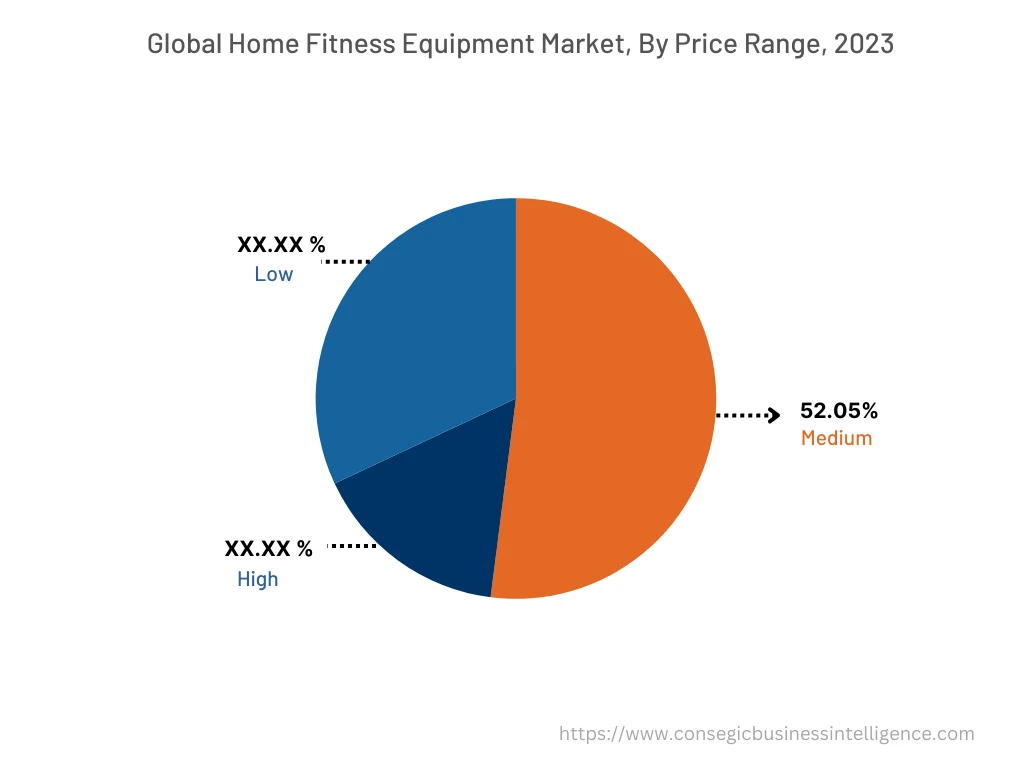
By Sales Channel :
Based on the sales channel, the market is segregated into online and offline.
The offline segment accounted for the largest revenue share of the total home fitness equipment market share in the year 2023. Offline sales channel involves the distribution of this equipment from manufacturers to the end-users indirectly through offline distributors including specialty stores, and retail outlets among others. Moreover, the expansion of the offline segment is primarily driven by several factors including higher credibility, ease of customization as per the target market, and strong customer base among others.
- For instance, Johnson Fitness & Wellness is a manufacturer of this equipment that provides a wide range of home exercise equipment that is available for purchase in over 100 retail stores spread across the United States.
Therefore, the increasing availability of this equipment in offline sales channels is a prime factor driving the home fitness equipment market growth.
Online is expected to witness the fastest CAGR during the forecast period. Online sales channel provides a distribution mode in which the manufacturers sell products through the company websites or any other third-party e-commerce websites that are available on the internet. Thus, online sales channels offer several benefits such as easy access to the products, faster buying process, higher flexibility, and quicker comparison of multiple products and prices among others. The above benefits of online sales channels are key determinants for driving its utilization for the distribution of this equipment.
- For instance, Technogym S.p.A is among the few equipment manufacturers that provide a range of fitness equipment for online purchase through the company website along with multiple e-commerce websites including eBay, Amazon, and others.
Hence, the rising availability of fitness equipment in online sales channels is projected to drive home fitness equipment market expansion in the region during the forecast period.
By Region :
The regional segment includes North America, Europe, Asia Pacific, the Middle East and Africa, and Latin America.
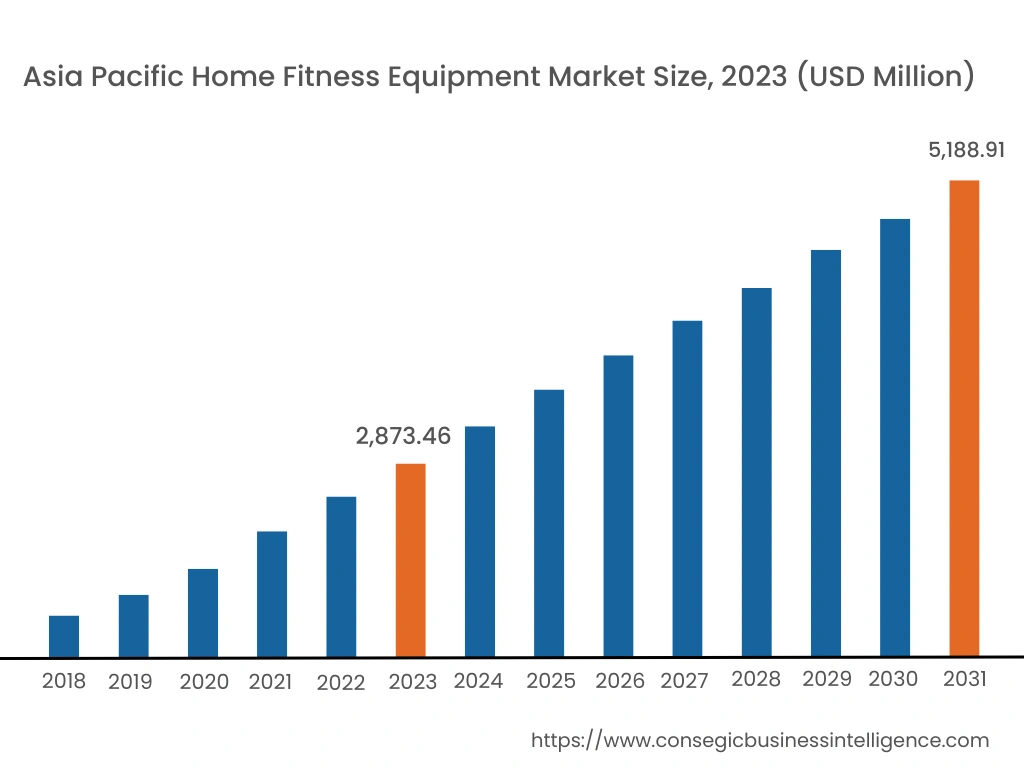
Asia-Pacific accounted for the largest revenue share of USD 2,873.46 Million in 2023 and is expected to reach USD 5,188.91 Million by 2031, registering the highest CAGR of 7.7% during the forecast period. In addition, in the region, China accounted for the maximum revenue share of 27.9% in the same year. The rising pace of urbanization, increasing disposable income, and growing popularity of fitness and bodybuilding trends among younger individuals are providing lucrative growth prospects for the market in the region. Additionally, based on the home fitness equipment market analysis, rising cases of obesity and growing health concerns are significant factors boosting the home fitness equipment market growth in the Asia-Pacific region.
- For instance, according to the EU-ASEAN Business Council, over 30 million adults are living with obesity in the ASEAN region as of 2022, and the obesity rate is estimated to increase up to 52.4 million adults by 2030.
Therefore, the rising incidence of obesity cases is driving the adoption of fitness equipment for facilitating home workout sessions for improved weight management, weight loss, and overall physical well-being, thereby, boosting the market growth in the Asia-Pacific region.
North America is expected to register a CAGR of 7.2% during the forecast period. The market growth for fitness equipment in the North American region is mostly driven by the rising obese population, increasing health concerns, and growing adoption of fitness equipment for facilitating physical well-being, weight management, and others.
- For instance, according to the Trust for America's Health's (TFAH) State of Obesity 2022 report, 19 states in the U.S. have obesity rates of over 35% as of 2022, depicting an increase from 16 states in 2021.
The rising rates of obesity are driving the market demand for fitness equipment to facilitate weight loss routines in the comfort of an individual's home, in turn boosting the market growth in North America. Additionally, the prevalence of several fitness equipment manufacturers in North America such as BlowFlex Inc., Johnson Fitness & Wellness, Rogue Fitness, Core Health & Fitness LLC, and others lead to significant innovations in fitness equipment in the North American region. The above factors are anticipated to drive market growth in North America during the forecast period.
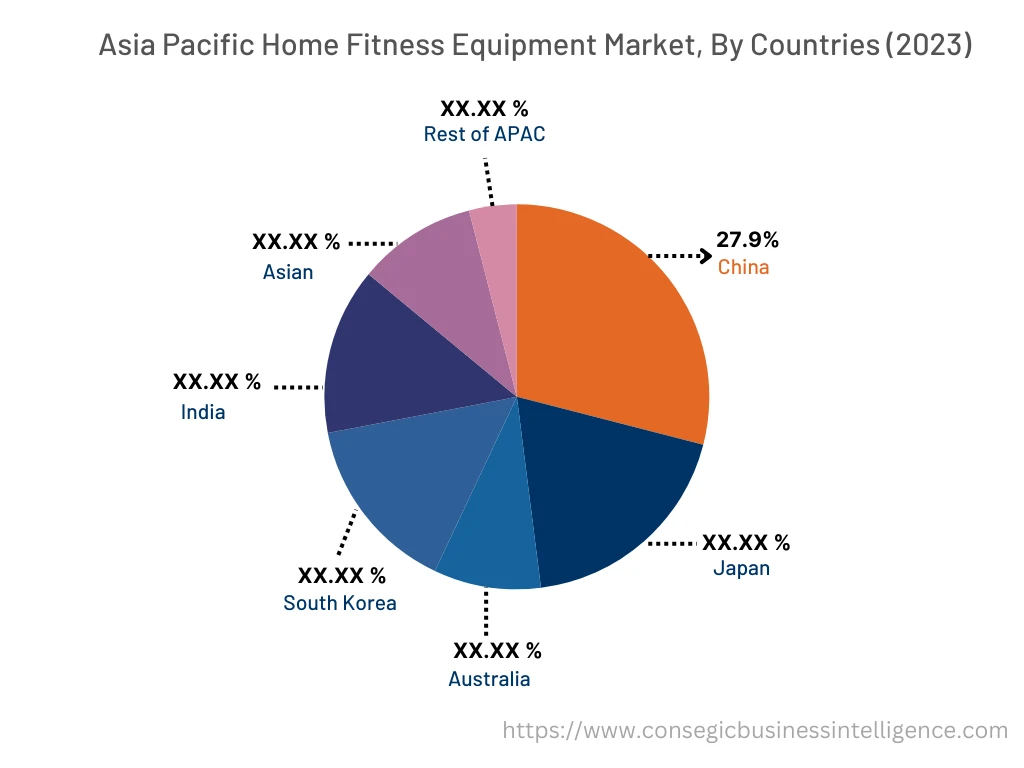
Top Key Players & Market Share Insights :
The global home fitness equipment market is highly competitive with major players providing fitness equipment to the national and international markets. Key players are adopting several strategies in research and development (R&D), product innovation, and sales channel launches to hold a strong position in the home fitness equipment market. Key players in the home fitness equipment industry include-
- BowFlex Inc.
- Johnson Fitness & Wellness
- Origin Fitness Ltd
- Rogue Fitness
- Technogym S.p.A
- Dyaco
- TRUE Fitness
- HOIST Fitness Systems
- Decathlon SA
- Core Health & Fitness LLC
Recent Industry Developments :
- In June 2022, Johnson Health Tech acquired the fitness division of Cravatex Brands Limited, in order to launch the company's first wholly-owned subsidiary in India.
Key Questions Answered in the Report
What is home fitness equipment? +
Home fitness equipment refers to devices or apparatus that are intended to be used in a residential setup during physical activity to enhance the strength, conditioning effects, or outcome of an exercise routine.
What specific segmentation details are covered in the home fitness equipment report, and how is the dominating segment impacting the market growth? +
For instance, by product type segment has witnessed treadmills as the dominating segment in the year 2023, owing to the increasing adoption of treadmills for cardio training in home workout sessions.
What specific segmentation details are covered in the home fitness equipment market report, and how is the fastest segment anticipated to impact the market growth? +
For instance, by sales channel segment has witnessed online sales channel as the fastest-growing segment during the forecast period due to increasing availability of home fitness equipment in online sales channels including company websites and e-commerce website.
Which region/country is anticipated to witness the highest CAGR during the forecast period, 2024-2031? +
Asia-Pacific is anticipated to register fastest CAGR growth during the forecast period due to rising pace of urbanization, increasing disposable income, and growing popularity of fitness and body building trend among younger individuals.
